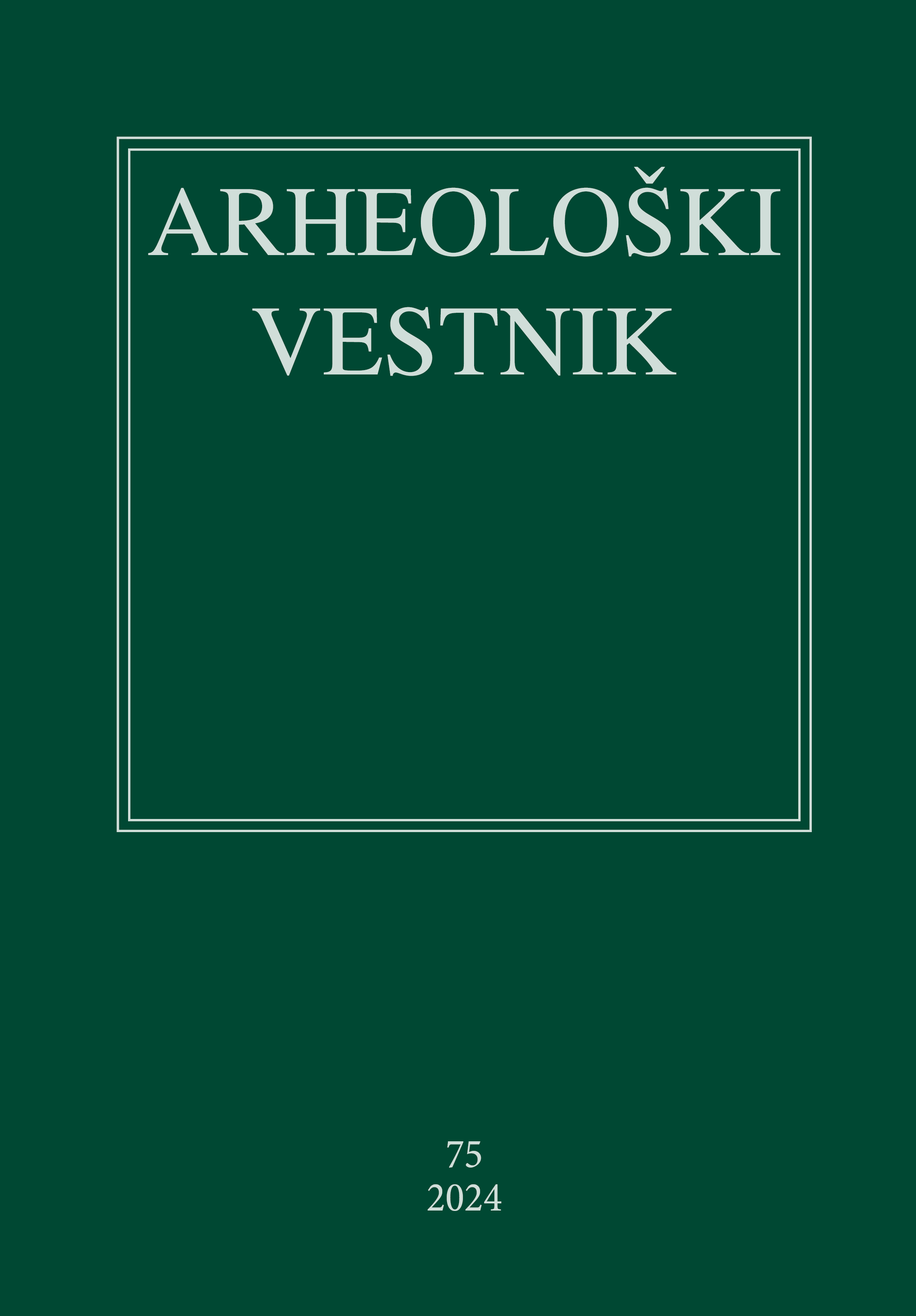Dressing Situla people: prehistoric textile remains from the Dolenjski muzej Novo mesto
DOI:
https://doi.org/10.3986/AV.75.04Keywords:
Slovenia, Dolenjska, Iron Age, textiles, fibre identification, wool quality, identityAbstract
This contribution examines the Iron Age textiles (8th−4th century BCE) kept at the Dolenjski muzej in Novo mesto, Slovenia, with the aim of identifying their raw materials, technologies, functions and social significance and situating them in a wider European context. The primary textile weave identified is a wool twill, which is typical for the Hallstatt culture and Italic textile traditions. Wool quality analysis indicates a local raw material with different processing methods. Certain diachronic changes are identified in textile structural characteristics, which may be indicative of influences from other regions.
Downloads
References
BANCK-BURGESS, J. 2012, Instruments of Power. Celtic Textiles. Mittel der Macht. Textilien bei den Kelten. − Stuttgart.
BELANOVA ŠTOLCOVA, T. 2012, Slovak and Czech Re- publics. − In: M. Gleba, U. Mannering (eds.), Textiles and Textile Production in Europe from Prehistory to AD 400. − Ancient Textiles Series 11, 306–333.
BENDER JØRGENSEN, L. 2005, Hallstatt and La Tène Textiles from the Archives of Central Europe. − In: P. Bichler et al. (eds.), “Hallstatt Textiles” Technical Analysis, Scientific Investigation and Experiment on Iron Age Textiles. − British Archaeological Reports Int. Series 1351, 133–150.
CHEN, H.L., K.A. JAKES, D.W. FOREMAN 1998, Pres- ervation of Archaeological Textiles Through Fibre Mineralization. − Journal of Archaeological Science 25, 1015–1021.
CULIBERG, M., A. ŠERCELJ 1995, Karpološke in antra- kotomske analize iz prazgodovinskih višinskih naselij na Dolenjskem (Karpologische und anthrakotomische Analysen aus den vorgeschichtlichen Höhensiedlungen in Dolenjsko). – Arheološki vestnik 46, 169−176.
DULAR, J. 2021, Gradivo za topografijo Dolenjske, Po- savja in Bele krajine v železni dobi. − E-Monographiae Instituti Archaeologici Sloveniae 10. https://doi.org/10.3986/9789610505105
DULAR, J., TECCO HVALA, S. 2012, South-eastern Slovenia in the Early Iron Age. Settlement – economy – society / Jugovzhodna Slovenija v starejši železni dobi. Poselitev – gospodarstvo – družba. – Opera Instituti archaeologici Sloveniae 12. https://doi.org/10.3986/9789612545239
EMERY, I. 1966, The Primary Structures of Fabrics. An Illustrated Classification. − Washington DC.
GABROVEC, S. 1960, Grob z oklepom iz Novega mesta (Panzergrab von Novo mesto). − Situla 1, 27−79.
GABROVEC, S. 1968, Grob s trinožnikom iz Novega mesta (Das Dreifussgrab aus Novo mesto. −Arheološki vestnik 19, 157−188.
GLEBA, M. 2017a, Tracing textile cultures of Italy and Greece in the early first millennium BC. − Antiquity 144, 1205–22. https://doi.org/10.15184/aqy.2017.144
GLEBA, M. 2017b, Textiles in pre-Roman Italy: from quali- tative to quantitative approach. − Origini XL/1, 9–28.
GRÖMER, K. 2012, Austria: Bronze and Iron Ages. − In: M. Gleba, U. Mannering (eds.), Textiles and Textile Pro- duction in Europe from Prehistory to AD 400. Ancient Textiles Series 11, 27–64.
GRÖMER, K. 2016, The Art of Prehistoric Textile Making – The development of craft traditions and clothing in Central Europe. − Vienna.
GRÖMER, K., A. KERN, H. RESCHREITER, H. RÖSEL- -MAUTENDORFER (eds.) 2013, Textiles from Hallstatt. Weaving Culture in Bronze and Iron Age Salt Mines. − Archaeolingua 29.
GUŠTIN, M., B. KRIŽ 2007, Lady and her Attire. Reflecti- ons of Status and Cult in Grave 30/4 from Ivanec near Družinska vas. − Situla 44, 491−503.
KNEZ, T. 1986, Novo mesto 1. Halštatski grobovi / Hall- stattzeitliche Gräber. − Carniola Archaeologica 1.
KRIŽ, B. 2019, Novo mesto 8. Kapiteljska njiva. Način pokopa v starejši železni dobi dobi / Burial rite in the Early Iron Age. − Carniola Archaeologica 8.
KRIŽ, B., M. JEREB 2014, Novo mesto. Mestne njive. − In: B. Teržan, M. Črešnar (eds.), Absolutno datiranje bro- naste in železne dobe na Slovenskem / Absolute Dating of the Bronze and Iron Ages in Slovenia. − Katalogi in monografije 40, 469−472.
LAU, R. 2021, Mineralisierte Textilreste aus hallstattzeitli- chen Gräbern in Slowenien. − In: K. Grömer, A. Kern (eds.), Prähistorische Forschungen Online 11, 6−15.
RAST-EICHER, A. 2008, Textilien, Wolle, Schafe der Eisenzeit in der Schweiz. − Antiqua 44.
RYDER, M.L. 1969, Changes in the fleece of sheep followingdomestication. − In: P.J. Ucko, G.W. Dimbleby (eds.), Thedomestication and exploitation of plants and animals, 495–521. – London.
SKALS, I., M. GLEBA, M. TAUBE, U. MANNERING 2018, Wool textiles and archaeometry: testing reliability of archaeological wool fibre diameter measurements. − Danish Journal of Archaeology 7/2, 161–179. doi:10.1080/21662282.2018.1495917
TERŽAN, B. 2021, Regional coherence and group identities in the Hallstatt culture in the south-eastern Alpine region. − In: Brun, P., Chaume, B., Sacchetti, F. (eds), Vix et le phénomène princier, Actes du colloque de Châtillonsur-Seine, 2016. − DAN@ 5, 163−178.
Downloads
Published
How to Cite
Issue
Section
License
Copyright (c) 2024 Authors

This work is licensed under a Creative Commons Attribution-ShareAlike 4.0 International License.
Authors guarantee that the work is their own original creation and does not infringe any statutory or common-law copyright or any proprietary right of any third party. In case of claims by third parties, authors commit their self to defend the interests of the publisher, and shall cover any potential costs.
More in: Submission chapter





